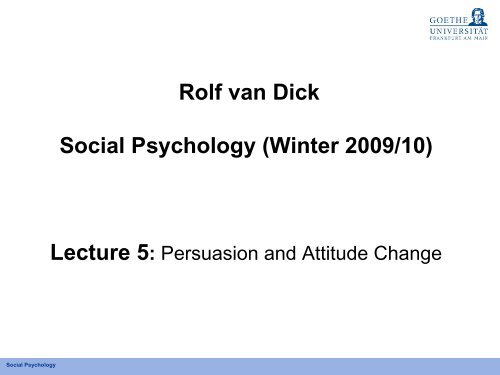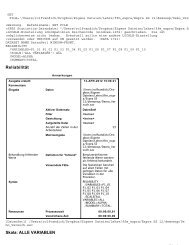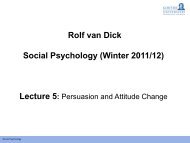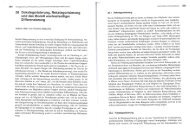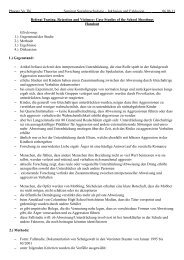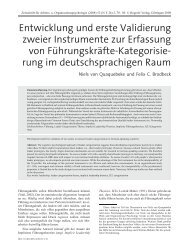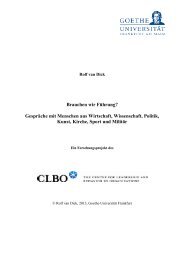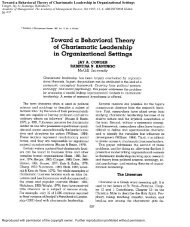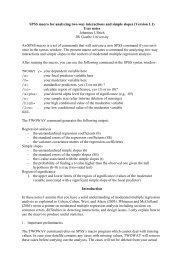Attitude inoculation - Sozialpsychologie
Attitude inoculation - Sozialpsychologie
Attitude inoculation - Sozialpsychologie
Create successful ePaper yourself
Turn your PDF publications into a flip-book with our unique Google optimized e-Paper software.
Rolf van Dick<br />
Social Psychology (Winter 2009/10)<br />
Lecture 5: Persuasion and <strong>Attitude</strong> Change<br />
Social Psychology
Sample MC-Items (last week)<br />
1) According to which model are attitudes described variously as<br />
containing feelings, likes, dislikes, behavioural intentions, thoughts and<br />
ideas?<br />
A) the three component model B) the dual model of attitudes<br />
C) the cognitive consistency model D) the one-component model<br />
2) Dissonance theory and balance theory are both examples of:<br />
A) accidental discoveries in the study of attitudes<br />
B) cognitive consistency theories<br />
C) social identity theory<br />
D) behaviourism in the study of attitudes<br />
Social Psychology
Sample MC-Items (last week)<br />
3) The theory of planned behaviour extended the theory of reasoned<br />
action by:<br />
A) specifying the questions that are asked in order to predict behaviour<br />
B) re-arranging the three components of “beliefs“, “intentions“ and<br />
“action“<br />
C) adding the variable of perceived behavioural control<br />
D) defining “intention“<br />
4) In balance theory, a triad is balanced when there is (are):<br />
A) two positive relationships<br />
B) just one negative relationship<br />
C) an odd number of negative relationships<br />
D) none of the above<br />
Social Psychology
Schedule<br />
1. Introducing Social Psychology 14.10.<br />
2. Attribution and Social Knowledge 21.10.<br />
3. Self and Identity 28.10.<br />
4. <strong>Attitude</strong>s 04.11.<br />
5. Persuasion and <strong>Attitude</strong> Change 11.11.<br />
6. Social Influence 18.11.<br />
7. People in Groups 25.11.<br />
8. Prejudice and Discrimination 02.12.<br />
9. Intergroup Behavior 09.12.<br />
10.Leadership and Decision Making 16.12.<br />
11.Aggression 13.01.<br />
12.Affiliation, Attraction, and Love 20.01.<br />
13.Prosocial Behavior 27.01.<br />
14.Revision 03.02.<br />
15.Exam 10.02.<br />
Social Psychology
Social Psychology<br />
Some terms (1/2)<br />
• Persuasion - Überzeugung/Überredung<br />
• neatly – ordentlich<br />
• extraneous – von außen<br />
• to enhance – fördern / steigern<br />
• uptight – angespannt<br />
• distracted – zerstreut<br />
• compliance – Folgsamkeit / Fügsamkeit<br />
• to enhance – erleichtern<br />
• ingratiation – Anbiederung<br />
• to emphasise - betonen<br />
• Elaboration-likelihood model – Modell der Verarbeitungstiefe<br />
• attempt - Versuch<br />
• Inoculation – Impfung
Some terms (2/2)<br />
• trustworthiness – Vertrauenswürdigkeit / Zuverlässigkeit<br />
• Source derogation – Abwertung der Quelle (der Botschaft)<br />
• tedium – Überdruss<br />
• slight – ein wenig<br />
• heuristics – Faustregeln<br />
• superficial – oberflächlich<br />
• to preserve – bewahren / beibehalten<br />
• obvious – offensichtlich<br />
• to induce – herbeiführen / bewegen<br />
• assault – Angriff<br />
• conformity - Angepasstheit<br />
Social Psychology
Focus Questions<br />
• Someone offers you sum of money for your prized racing bike,<br />
which you believe is a fair prize. After they have checked their bank<br />
balance, the would-be purchaser reduces the offer by 15%, saying<br />
that‘s all they can afford. Could such a tactic work?<br />
• You have just joined the army. Along with other cadets you listen to<br />
an amazing talk by an officer skilled in the use of survival techniques<br />
in difficult combat conditions. Among other things, he asks you to<br />
eat some fried grasshoppers. „Try to imagine this is the real thing!<br />
You know, you might have to do this to save your live one day“, he<br />
says. Despite your first reaction, you go ahead and eat them. Would<br />
you end up liking the delicacy more if the officer‘s style of<br />
presentation was warm and friendly or cold and distant?<br />
Social Psychology
Teaching objectives<br />
In General<br />
The various models of the persuasion process; tactics for<br />
enhancing compliance; the theory of cognitive<br />
dissonance and factors which guard against attitude<br />
change.<br />
Social Psychology
Teaching objectives<br />
Specific topics I<br />
<strong>Attitude</strong>s, arguments and behaviour<br />
• Discrepancies between attitude and behaviour allow attitude change<br />
to occur.<br />
• Two general approaches to attitude change – the first emphasises<br />
the use of persuasive arguments; the second emphasises<br />
behavioural involvement.<br />
Social Psychology
Teaching objectives<br />
Specific topics II<br />
Persuasive communications<br />
• The important links and steps in the persuasion process (e.g.<br />
communicator, message, and audience).<br />
• How persuasion is affected by features of the communicator (e.g.<br />
source credibility), features of the message and the medium (e.g.<br />
repetition, use of feararousal, appeals to affect versus fact, use of<br />
video, audio and written forms) and features of the audience (e.g.<br />
self-esteem, sex).<br />
• Current models of persuasion – Petty and Cacioppo’s elaborationlikelihood<br />
model; Chaiken’s heuristic-systematic processing model.<br />
Social Psychology
Teaching objectives<br />
Specific topics III<br />
Compliance: Interpersonal influence<br />
• Various tactics for enhancing compliance (e.g. ingratiation,<br />
reciprocity, and multiple request techniques such as the foot-in-thedoor,<br />
door-in-the-face and low-ball tactics).<br />
• The concept of action research and its application to attitude change.<br />
Social Psychology
Teaching objectives<br />
Specific topics IV<br />
<strong>Attitude</strong> behaviour discrepancy and cognitive dissonance<br />
• The nature of the theory of cognitive dissonance and its application<br />
to a variety of situations involving attitude or behaviour change.<br />
• Three research paradigms associated with the theory of cognitive<br />
dissonance – effort justification, induced compliance and free<br />
choice.<br />
• The strengths and weaknesses of cognitive dissonance theory and<br />
to be aware of theoretical alternatives (e.g. self-perception theory).<br />
Social Psychology
Teaching objectives<br />
Specific topics V<br />
When attitude change fails<br />
• Three major reasons why attempts at persuasion fail – reactance,<br />
forewarning and the <strong>inoculation</strong> effect.<br />
• How knowledge of these factors can be used to reduce the likelihood<br />
of attitude change.<br />
Social Psychology
The persuasion process:<br />
communicator, message, and audience<br />
The field of attitude change is vast and complex.<br />
Hovland headed the Yale approach to<br />
communication and persuasion, which studied<br />
variables dealing with the communicator, the<br />
source of the message, the message itself, and<br />
the context in which persuasion occurs.<br />
Social Psychology
The Yale approach to communication and persuasion<br />
Social Psychology<br />
Based on Janis & Hovland (1959).
The effect of communicator credibility and position<br />
discrepancy on opinion change<br />
Social Psychology<br />
Based on data from Bochner & Insko (1996).
The effects of source modality and message<br />
difficulty on opinion change<br />
Social Psychology<br />
Based on Chaiken & Eagly (1983).
The persuasion process:<br />
communicator, message, and audience<br />
• Several aspects of a communicator affect<br />
whether a person is evaluated favorably.<br />
– Credibility<br />
• Expertise<br />
• Trustworthiness<br />
– Liking<br />
Social Psychology
The persuasion process:<br />
communicator, message, and audience<br />
• We are persuaded by the opinions of our<br />
reference groups, those we like or identify<br />
with.<br />
– This occurs both because of the motivational<br />
factors of liking and perceived similarity, and<br />
because messages from in-groups are more likely<br />
to be processed using the central route (see ELM<br />
later).<br />
Social Psychology
The persuasion process:<br />
communicator, message, and audience<br />
• Source derogation involves deciding the source<br />
is unreliable or negative in some way. It can<br />
make all future as well as current arguments<br />
from that source less powerful.<br />
Social Psychology
The persuasion process:<br />
communicator, message, and audience<br />
• Repetition and familiarity tend to increase<br />
liking, but only up to a point.<br />
• Repetition may help people process strong<br />
arguments more completely but expose the flaws in<br />
weak arguments.<br />
• Repetition may lead to tedium; this can be dealt<br />
with by having ads that provide slight variations on<br />
a theme.<br />
Social Psychology
Dual process models of persuasion<br />
Two important areas of our lives that employ relevant<br />
principles from social psychological research are<br />
advertising and political propaganda.<br />
Two models, each dealing with how a persuasive message<br />
is learned, draw on developments in research on<br />
cognition. Petty and Cacioppo’s elaboration likelihood<br />
model proposes that, when people attend to a message<br />
carefully, they use a central route to process it; otherwise<br />
they use a peripheral route. Chaiken’s heuristic–<br />
systematic model suggests that people use systematic<br />
processing when they attend to a message carefully;<br />
otherwise they use heuristic processing.<br />
Social Psychology
Dual process models of persuasion<br />
Both theories state that under certain<br />
conditions, people are motivated to pay<br />
attention to and think about the facts in a<br />
message; this is referred to as the central<br />
route to persuasion.<br />
Social Psychology
Dual process models of persuasion<br />
Under other conditions, people are not<br />
motivated to pay attention to the facts a<br />
message presents and only attend to<br />
superficial characteristics such as who<br />
delivers it and how long it is. In this case<br />
people may be influenced by the peripheral<br />
route to persuasion.<br />
Social Psychology
The elaboration–likelihood<br />
model of persuasion<br />
Petty & Cacioppo (1986)<br />
Social Psychology
Dual process models of persuasion<br />
Which route to attitude change will people<br />
take? One determinant is the personal<br />
relevance of the topic. The more relevant the<br />
topic, the more people will take the central<br />
route to persuasion. Here, they will be<br />
influenced the most by the strength of the<br />
arguments.<br />
Social Psychology
Social Psychology<br />
Dual process models of persuasion
Dual process models of persuasion<br />
The route to attitude change also depends on<br />
people’s ability to pay attention to the<br />
arguments. The more distracted people are,<br />
the more they will take the peripheral route.<br />
Social Psychology
Dual process models of persuasion<br />
<strong>Attitude</strong> change will be more long-lasting if it<br />
occurs through the central route.<br />
Social Psychology
Dual process models of persuasion<br />
In order to get people to use the central<br />
processing route, you need to get their<br />
attention. This can be done by playing to<br />
their emotions.<br />
Social Psychology
Dual process models of persuasion<br />
However, people want to preserve good<br />
moods, so they will avoid activities that might<br />
spoil their good mood. This means that<br />
people in good moods will often avoid paying<br />
close attention to a persuasive<br />
communication, because they think that doing<br />
so will lower their mood.<br />
Social Psychology
Dual process models of persuasion<br />
Fear-arousing communications are most<br />
effective if they induce a moderate amount of<br />
fear and people believe that listening to the<br />
message will reduce this fear. If the<br />
message is too scary or not scary enough, it<br />
will fail.<br />
Social Psychology
Social Psychology<br />
The inverted U-curve relationship between<br />
fear and attitude change
Tactics for enhancing compliance<br />
A variety of techniques that deal with ways of<br />
inducing another person to comply with our<br />
requests has been intensively studied: these<br />
include ingratiation, reciprocity and guilt arousal.<br />
There are also multiple-request techniques (footin-the-door,<br />
door-in-the-face and low-balling), in<br />
which a first request functions as a set-up for the<br />
second, real request.<br />
Social Psychology
Social Psychology<br />
Three classic techniques for inducing compliance
The foot-in-the-door technique: compliance with an<br />
impossible request followed by a possible request<br />
Based on data from<br />
Dolinski (2000), Experiment 2<br />
Social Psychology
The theory of cognitive dissonance<br />
Festinger’s cognitive dissonance theory is a major<br />
approach to the topic of attitude change. It<br />
addresses not only conflict between a person’s<br />
beliefs but discrepancy between behaviour and<br />
underlying attitudes, and behaviour and selfconception.<br />
It includes three variations on the<br />
way in which dissonance is brought about: effort<br />
justification, induced compliance and free<br />
choice.<br />
Social Psychology
Social Psychology<br />
The theory of cognitive dissonance
The effect of incentives on evaluating a boring task<br />
in an induced- compliance context<br />
Social Psychology<br />
Based on data from Festinger & Carlsmith (1959).
Interest in a group discussion in relation to the<br />
severity of the initiation procedure<br />
Based on data from Aronson & Mills (1959).<br />
Social Psychology
Change in weight among overweight women after<br />
expending psychological effort<br />
Social Psychology<br />
Based on data from Cooper & Axom (1982).
Degree of liking fried grasshoppers as food by military<br />
cadets in relation to the interpersonal style of an officer<br />
Based on data from Zimbardo, Weisenberg, Firestone & Levy (1965).<br />
Social Psychology
Resistance to persuasion<br />
Reactance is an increase in resistance to<br />
persuasion when the communicator’s efforts to<br />
persuade are obvious. Techniques for building<br />
up resistance include forewarning and the<br />
<strong>inoculation</strong> defence. In recent years,<br />
manufacturing companies have used inoculating<br />
media releases to shore up consumer loyalty.<br />
Social Psychology
Resistance to persuasion<br />
• <strong>Attitude</strong> Inoculation<br />
One way to bolster people against persuasion<br />
attempts is to have them consider the arguments for<br />
and against their attitude before somebody attacks it.<br />
Social Psychology
Resistance to persuasion<br />
• <strong>Attitude</strong> Inoculation<br />
McGuire (1964)<br />
<strong>Attitude</strong> <strong>inoculation</strong> procedure does this by exposing<br />
people to a small dose of the argument against their<br />
position; this induced them to counter-argue and<br />
provide a “vaccination” that helps people ward off<br />
later, stronger influence attempts.<br />
Social Psychology
Resistance to persuasion<br />
• Resisting Peer Pressure<br />
<strong>Attitude</strong> <strong>inoculation</strong> that is designed to combat<br />
affectively based persuasion techniques can be<br />
effective at helping people resist peer pressure.<br />
Social Psychology
Resistance to persuasion<br />
• When Persuasion Attempts Boomerang:<br />
Reactance Theory<br />
Brehm (1966)<br />
It is important not to use too heavy a hand when trying<br />
to immunize people against assaults on their attitudes.<br />
If you administer too strong a prohibition, the<br />
prohibition may boomerang and lead to an increase in<br />
the prohibited activity.<br />
Social Psychology
Resistance to persuasion<br />
• When Persuasion Attempts Boomerang:<br />
Reactance Theory<br />
Reactance theory explains this by saying that strong<br />
prohibitions threaten a person’s feeling of freedom,<br />
and engaging in the forbidden behavior is an attempt<br />
to restore that feeling of freedom.<br />
Social Psychology
Literature, Film and TV<br />
• Tin Men: 1987 comedy written and directed by Barry Levinson,<br />
starring Richard Dreyfuss and Danny Devito. Two aluminium<br />
salesmen are in competition. They use all their skills to outsell each<br />
other by persuading customers.<br />
• Matchstick Men: 2003 black comedy by Ridley Scott, starring<br />
Nicholas Cage. A pair of con artists spend their lives engaging in<br />
persuasion and living a double life to avoid being caught. They pull<br />
off scams, but the last huge scam backfires big time on Nicholas<br />
Cage’s character who becomes the victim of his own con.<br />
• Glengarry Glen Ross: 1992 film directed by James Foley, written by<br />
David Mamet, and starring Jack Lemmon, Al Pacino, Ed Harris,<br />
Kevin Spacey, Alec Baldwin and others. The film is about real estate<br />
office and the different ways in which salesmen under pressure try<br />
to sell, and to persuade others.<br />
Social Psychology
Your Portfolio<br />
• Read the chapter along the slides!<br />
• Answer the sample questions!<br />
• What have I learned?<br />
• What did I NOT understand?<br />
• How can I apply the knowledge?<br />
Social Psychology
Sample MC-Items<br />
1) One of the following characteristics is a minimum requirement for a<br />
persuasive message to have some success:<br />
A) the message has to be written neatly<br />
B) no extraneous factor should interrupt the information flow<br />
C) the audience needs to give some attention to the message<br />
D) the message must be very sensible<br />
2) The content of a message has an impact on whether people are<br />
persuaded or not. Which of the following is NOT directly related to the<br />
message component?<br />
A) Fear-arousing messages are more likely to persuade<br />
B) Evaluatively biased terminology enhances persuasion<br />
C) A message delivered by an expert is more persuasive than one<br />
delivered by a non-expert<br />
D) People are more easily persuaded if they think that the message is not<br />
aimed at them<br />
Social Psychology
Sample MC-Items<br />
3) When Karen hears graphic news about disasters she becomes<br />
somewhat stressed, focussed and attentive. However, when she gets<br />
extremely stressed, she is so uptight that she becomes distracted from<br />
the details of the story. This sequence characterises the:<br />
A) J-curve B) boomerang effect<br />
C) reactance response D) the inverted U-curve<br />
4) In Petty and Cacioppo‘s (1986) elaboration-likelihood model<br />
A) people are never assumed to take mental shortcuts<br />
B) a central route is used when the message is delivered in visual form<br />
C) a peripheral route is used when attention to the argument of a<br />
message is low<br />
D) persuasion occurs only when the source is likeable<br />
Social Psychology


